By Rachel Gann & Haley Walker (Edited by Noel T. Manning II)
“Monsters are real, and ghosts are real too. They live inside us, and sometimes, they win.” – Stephen King
 There are your typical horror/thriller authors, and then there is Stephen King. From a demented fangirl who forces her favorite author to write a sequel, to a shape-shifting clown who feeds on small children’s fear, Stephen King has a knack for scaring his audiences. He also engages people with coming of age stories, time travel and the wrongfully accused. King has taken audiences into the past, present, other dimensions and apocalyptic futures. His works are intriguing, engaging, at times terrifying, yet many of his story’s messages are universal.
There are your typical horror/thriller authors, and then there is Stephen King. From a demented fangirl who forces her favorite author to write a sequel, to a shape-shifting clown who feeds on small children’s fear, Stephen King has a knack for scaring his audiences. He also engages people with coming of age stories, time travel and the wrongfully accused. King has taken audiences into the past, present, other dimensions and apocalyptic futures. His works are intriguing, engaging, at times terrifying, yet many of his story’s messages are universal.
With novels, such as The Stand, The Green Mile, The Shining, Salem’s Lot, and It, King has become one of the most well-known authors of gothic horror/thrillers. King’s writing spans over 40 years and 60 books, making him one of the world’s most prolific and successful authors; the “Grandmaster of Horror” has also had nearly 100 of his works 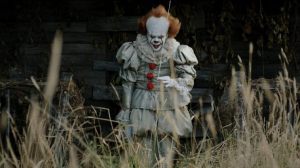 adapted into film and television scripts (Sobbart, 2017).
adapted into film and television scripts (Sobbart, 2017).
“Life is like a wheel. Sooner or later, it will always come around to where you started again.” – Stephen King
Stephen King was born September 21, 1947 in Portland, Maine, and during his early years, he also lived in Connecticut and Indiana. Stephen and his older brother, David, were raised by mother, Nellie (The Author, para.1, stephenking.com), and when Stephen was eleven, the family settled in Durham, Maine, so Nellie could care for her elderly parents. This would prove a formative time (and place) for King and for his future writings. When his grandparents passed away, Nellie found work in Pineland Hospital, a nearby residential facility for the mentally challenged (Stephen King Biography, IMDB). For anyone who has read the works of King, or seen films and TV shows based on his works, it is obvious that Maine serves as a backdrop for many of his stories.
Upon graduation from high school, King went on to attend the University of Maine at 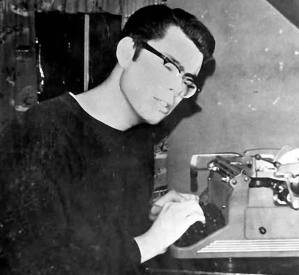 Orono, and there he engaged his passion for writing. He wrote a weekly column for the school newspaper, The Maine Campus, and was also a member of the Student Senate (The Author, para. 2, stephenking.com). While there, he also sold his first short story The Glass Floor to Startling Mystery Stories. He was active in student politics, and was a strong advocate for the anti-war movement on his college’s campus. (The Author, para. 2, stephenking.com). He was drafted for the Vietnam War, but he failed his draft-board examination on grounds of high blood pressure, flat feet, punctured eardrums, and limited vision. He would eventually reveal that he suffers from macular degeneration, an incurable condition that will most likely lead to blindness (Stephen King Biography, IMDB).
Orono, and there he engaged his passion for writing. He wrote a weekly column for the school newspaper, The Maine Campus, and was also a member of the Student Senate (The Author, para. 2, stephenking.com). While there, he also sold his first short story The Glass Floor to Startling Mystery Stories. He was active in student politics, and was a strong advocate for the anti-war movement on his college’s campus. (The Author, para. 2, stephenking.com). He was drafted for the Vietnam War, but he failed his draft-board examination on grounds of high blood pressure, flat feet, punctured eardrums, and limited vision. He would eventually reveal that he suffers from macular degeneration, an incurable condition that will most likely lead to blindness (Stephen King Biography, IMDB).
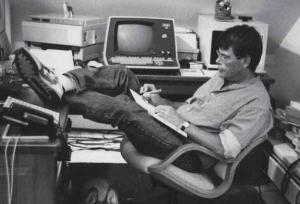 He graduated from college and earned a Bachelor of Arts in English in 1970, and married his college sweetheart, Tabitha Spruce In 1971 (they are still married today). He started writing more short stories during this time, to provide additional income to his family (while also searching for a stable job). Many of these works were sold throughout the early years of their marriage, and were later gathered into his best-selling Night Shift collection.
He graduated from college and earned a Bachelor of Arts in English in 1970, and married his college sweetheart, Tabitha Spruce In 1971 (they are still married today). He started writing more short stories during this time, to provide additional income to his family (while also searching for a stable job). Many of these works were sold throughout the early years of their marriage, and were later gathered into his best-selling Night Shift collection.
In the fall of 1971, he got a job teaching public high school at Hampden Academy (The Author, para. 5, stephenking.com), and he spent his free time perfecting his writing craft by taking his storytelling to novel formats. His first novel, Carrie, a supernatural story about an abused outsider discovering her true gifts, was accepted for publication in the spring of 1973 (The Author, para. 5, stephenking.com). That same year, King’s editor, Bill Thompson, told him that “a major paperback sale would provide him with the means to leave teaching and write full-time”(The Author, stephenking.com). Thompson was right, and King’s world soon changed. Carrie hit the shelves in 1974, and by 2017, King had produced works that collectively sold “an estimated 350 million books” (Rollingstone.com, Stephen King).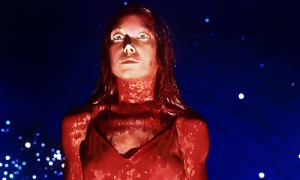
Carrie launched Kings career as a unique and terrifying writer, and In an interview with Rolling Stone, King explained why most of his books are horror/supernatural in nature and why he was drawn to that particular genre. “It’s built in. That’s all. The first movie I ever saw was a horror movie. It was Bambi. When that little deer gets caught in a forest fire, I was terrified, but I was also exhilarated. I can’t explain it…“ (Rollingstone.com, Stephen King para. 6). King also explores themes such as guilt, as seen in 1922 (2017), friendship like the ones we see in Stand by Me (1986) and facing one’s fears, IT (1990, 2017). But, for some reason the stories exploring the limits of fear tend to draw audiences in the most.
“And as a writer, one of the things that I’ve always been interested in doing, is actually invading your comfort space. Because that’s what we’re supposed to do. Get under your skin, and make you react.” – Stephen King
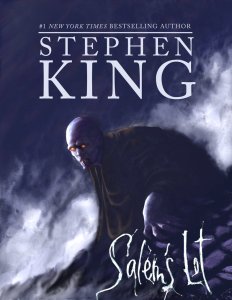 The next few years proved to be filled with ideas and opportunity for King. In the summer of 1973, King wrote his next novel ‘Salem’s Lot (originally titled The Second Coming, and then Jerusalem’s Lot), and in 1974, the Kings moved to Boulder, Colorado. They lived there for less than a year, but during this time King wrote The Shining (The Author, para. 7, stephenking.com). The summer of 1975, the Kings bought a home back in Maine, and at that house, King finished writing The Stand, and wrote The Dead Zone (The Author, para. 7, stephenking.com). While many of these stories were indeed filled with terror, fear and the supernatural, several also offered a glimmer of hope and heroes along the journey. “It’s better to be good than evil,” King said, “But one achieves goodness at a terrific cost” (Stephen King Quotes, brainyquote.com).
The next few years proved to be filled with ideas and opportunity for King. In the summer of 1973, King wrote his next novel ‘Salem’s Lot (originally titled The Second Coming, and then Jerusalem’s Lot), and in 1974, the Kings moved to Boulder, Colorado. They lived there for less than a year, but during this time King wrote The Shining (The Author, para. 7, stephenking.com). The summer of 1975, the Kings bought a home back in Maine, and at that house, King finished writing The Stand, and wrote The Dead Zone (The Author, para. 7, stephenking.com). While many of these stories were indeed filled with terror, fear and the supernatural, several also offered a glimmer of hope and heroes along the journey. “It’s better to be good than evil,” King said, “But one achieves goodness at a terrific cost” (Stephen King Quotes, brainyquote.com).
“If you want to be a good writer, you must do two things above all others: read a lot and write a lot.” – Stephen King
King’s story ideas poured out during the next decade as if powered through a firehose,  and he decided to do something a little different. He wrote several novels under the pseudonym Richard Bachman, because he believed that the public wouldn’t buy more than one book from the same author in a year. Four of his early novels- Rage (1977), The Long Walk (1979), Roadwork (1981) and The Running Man (1982) -were published under the Bachman name. He came up with the moniker after seeing a novel by Richard Stark on his desk, while also listening to the song, “You Ain’t Seen Nothing Yet”, by Bachman Turner Overdrive (Stephen King, Biography.com). He would go on to write three more novels under that pseudonym – Thinner (1984), The Regulators (1996), and Blaze (2007).
and he decided to do something a little different. He wrote several novels under the pseudonym Richard Bachman, because he believed that the public wouldn’t buy more than one book from the same author in a year. Four of his early novels- Rage (1977), The Long Walk (1979), Roadwork (1981) and The Running Man (1982) -were published under the Bachman name. He came up with the moniker after seeing a novel by Richard Stark on his desk, while also listening to the song, “You Ain’t Seen Nothing Yet”, by Bachman Turner Overdrive (Stephen King, Biography.com). He would go on to write three more novels under that pseudonym – Thinner (1984), The Regulators (1996), and Blaze (2007).
The Kings would move several more times including a stint in London, England before settling in Bangor, Maine. After the success of his first novels, and the pressures of writing best-sellers, Stephen King would have bouts with declining health due to drug and alcohol abuse, until his wife staged an intervention. Her message to him was: “Get help or get out. We love you, but we don’t want to witness your suicide.” (Stephen King, IMDB). He listened, and knew he had to change; he received the help he needed and became sober. Since then, King has continued to have novels published, and 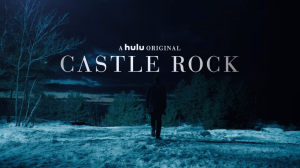 films adapted from his works. Some of these include Cujo (1983), Firestarter (1984), IT (1990, and a remake in 2017), and The Shining (1980). King wrote novels at a breakneck speed throughout the 80’s and 90’s, and he continues be involved in innovative works and provocative projects. He has worked directly with television, writing for series like Kingdom Hospital and Under the Dome (based off his 2009 novel). Inspired by his works, Hulu will also release a psychological horror series called Castle Rock in 2018, which will intertwine characters and themes from his works and take place in the fictional town of Castle Rock, Maine.
films adapted from his works. Some of these include Cujo (1983), Firestarter (1984), IT (1990, and a remake in 2017), and The Shining (1980). King wrote novels at a breakneck speed throughout the 80’s and 90’s, and he continues be involved in innovative works and provocative projects. He has worked directly with television, writing for series like Kingdom Hospital and Under the Dome (based off his 2009 novel). Inspired by his works, Hulu will also release a psychological horror series called Castle Rock in 2018, which will intertwine characters and themes from his works and take place in the fictional town of Castle Rock, Maine.
King has received numerous accolades for his works, earning several Bram Stoker 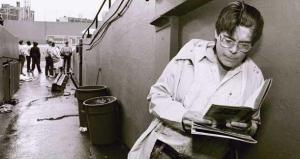 Awards, The O. Henry Award, and the Lifetime Achievement honor from the World Fantasy Awards (Awards, Stephenking.com). As of 2017, King had forty-three novels under his belt, along with eight collections of short stories, eleven screenplays, two books on the craft of writing, plus he is a co-author of Faithful which is a day-by-day account of the Red Sox’s MLB championship season in 2004. (Paris Review, Stephen King, The Art of Fiction, para. 4).
Awards, The O. Henry Award, and the Lifetime Achievement honor from the World Fantasy Awards (Awards, Stephenking.com). As of 2017, King had forty-three novels under his belt, along with eight collections of short stories, eleven screenplays, two books on the craft of writing, plus he is a co-author of Faithful which is a day-by-day account of the Red Sox’s MLB championship season in 2004. (Paris Review, Stephen King, The Art of Fiction, para. 4).
King shows no signs of slowing down, and with nearly 100 of his works adapted to film or TV already, his status as a writer (and film) legend looks to continue to expand. Stephen and Tabitha also have sons (Joe and Owen) who are becoming successful writers as well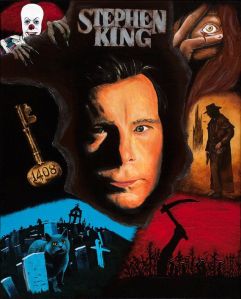
Trademarks
Every artist (whether filmmaker or writer) has trademarks that flow through their works; Stephen King is no exception. Many of his works have significant similarities, whether it be the setting or character types. One of his major trademarks is the use of Maine as the physical setting. Many of the male characters in his novels have occupations as writers, including Paul Sheldon from Misery, Mike Noonan from Bag of Bones, and Bill Denbrough from IT. He often uses horror and fantasy themes, and even supernatural elements. Many children/youth characters are often killed in his novels, including Tad from Cujo, Gage from Pet Semetary, Ray from The Body, and Georgie from IT. Many of his characters also experience hallucinations, such as Wilfred James from 1922 or Jessie Burlingame from Gerald’s Game. Readers will also discover that characters face inner demons as a result of self-inflicted mistakes or choices. Murder, imprisonment (physical or mental), revenge, the evil heart, and punishment for actions (or inactions) live throughout the themes, morals and messages of the King landscapes.
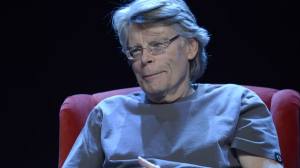 Stephen King has a unique way of mentioning his previous novels (or characters) in his works as a way of dropping Easter eggs for his audience. His also depicts small-town life filled with dark secrets and transports readers/viewers into the story by asking … “what if?”
Stephen King has a unique way of mentioning his previous novels (or characters) in his works as a way of dropping Easter eggs for his audience. His also depicts small-town life filled with dark secrets and transports readers/viewers into the story by asking … “what if?”
The end is near… or is it?
King can paint pictures that fuel imaginations; he can terrify or inspire you; he can feed your nightmares or your dreams. Some of his stories strike amazing similarities (Shawshank Redemption and the Green Mile), while others are like different sides of the same coin (Stand By Me and IT). Having written over five dozen novels, he continues to possess a creativity that filmmakers and television producers love to explore (Revival, The Mist, Doctor Sleep, The Long Walk). He has been compared to a cross between William Shakespeare and Edgar Allen Poe, and his ability to continually to dispense new works (almost in the blink of an eye) has also brought him into comparisons of filmmaker Woody Allen (who churns out new works annually).
King transcribes his own fears and create masterpieces that withstand the element of time. It’s something he continues to love, and he constantly reminds aspiring writers to take a chance, and find the adventure within their craft. “Do it for joy and you can do it forever. Let’s get one thing clear right now, shall we? There is no Idea Dump, no Story Central, no Island of the Buried Bestsellers; good story ideas seem to come quite literally from nowhere, sailing at you right out of the empty sky: two previously unrelated ideas come together and make something new under the sun. Your job isn’t to find these ideas but to recognize them when they show up.
― Stephen King
Bibliography
Gann, R. “A Look into the life and works of Stephen King.” Aware Winning Filmmakers, 2017. Comm 400A, Semester Paper, Gardner-Webb University, Boiling Springs, N.C.
Greene, A. (2014, October 31). Stephen King: The Rolling Stone Interview. Retrieved November 29, 2017, from http://www.rollingstone.com/culture/features/stephen-king-the-rolling-stone-interview-20141031
Hollywood script notes: Stephen king screenplay feedback. Retrieved February 25, 2018, from https://www.hollywoodscriptnotes.com/writer-spotlight
Manning , N. T., II. (2018). Stephen King: grandmaster of horror. Award Winning Filmmakers,18(Fall), 2018th ser., 2-25. Retrieved February 25, 2018.
Editor – Lecture – Article
Miyamotomo, K. (2017, August 30). 17 Must Read Screenwriting Lessons from Stephen King. Retrieved February 25, 2018, from https://screencraft.org/2015/09/27/17-must-read-screenwriting-lessons-from-stephen-king/
Screencraft
Paris Review: King. Interviewed by Christopher Lehmann-Haupt and Nathaniel Rich. (2017, October 13). Stephen King, The Art of Fiction No. 189. Retrieved November 28, 2017, from https://www.theparisreview.org/interviews/5653/stephen-king-the-art-of-fiction-no-189-stephen-king
S. (2017, November 1). Stephen King: The ‘King’ of Script to Screen. Retrieved February 25, 2018, from http://thepopcult.blog/stephen-king-the-king-of-script-to-screen/ . Alternative arts, style and culture
Stephen King (Goodreads Author), Bernie Wrightson (Illustrator)-Stephen Author)- Stephen King (Goodreads Author). Retrieved November 28, 2017, from www. goodreads.com/stephenking.
Stephen King Biography. IMDB.com. Retrieved November 28, 2017, from
http://www.imdb.com/name/nm0000175/
Stephen King Quotes. (n.d.). Retrieved February 25, 2018, from https://www.brainyquote.com/authors/stephen_king
Stephen King: Alcoholism, Drug Addiction, and Fame. Retrieved November 28, 2017, from https://detoxtorehab.com/celebrity/stephen-king-alcoholism-drug-addiction-and-fame
Stephen King: A Bio. Retrieved November 28, 2017, from
https://www.biography.com/people/stephen-king-9365136
Stephen King: The Biography. Retrieved November, 28, 2017, from
Stobbart, D. (2017) Lecturer in English and Creative Writing, Lancaster University, D. (2017, September 17). Stephen King: a master of horror who finds terror in the everyday. Retrieved February 25, 2018, from http://theconversation.com/stephen-king-a-master-of-horror-who-finds-terror-in-the-everyday-83758
Walker, Haley. “Review and analysis of Stephen King.” Award Winning Filmmakers, 2017. Comm 400A, Filmmakers Class, Gardner-Webb University, Boiling Springs, N.C.
####
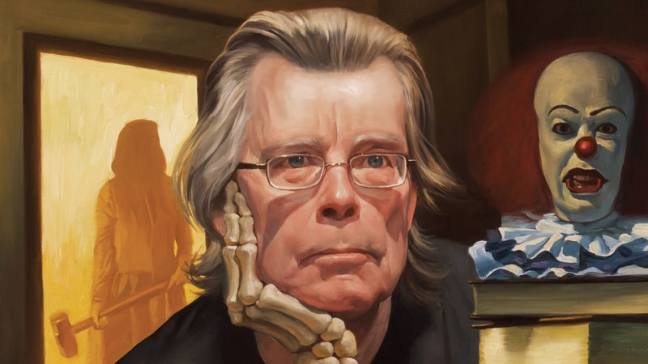

 guideline
guideline

















 Woody Allen (1935) is a multitalented filmmaker known for creating strong female leads, developing rich screenplays, infusing a script with finely tuned characters, and reinventing the romantic comedy. His quirky writing and sense of comic timing is a direct result of his experiences growing up with a demanding mother and nomadic father, who were second-generation Jewish immigrants.
Woody Allen (1935) is a multitalented filmmaker known for creating strong female leads, developing rich screenplays, infusing a script with finely tuned characters, and reinventing the romantic comedy. His quirky writing and sense of comic timing is a direct result of his experiences growing up with a demanding mother and nomadic father, who were second-generation Jewish immigrants. Born in Brooklyn, NY just prior to World War II offered a unique outlook on life for Allen growing up with the knowledge, and pain of Hitler’s Jewish Holocaust. He understood the plight of his kinsmen overseas, yet refused to allow the darkness of that time to break his spirit. He knew that had his family lived in Germany during this period, that he probably wouldn’t have survived to experience the beautiful chaos that is life. His father would bounce from job to job, never quite finding a place to settle, and he was everything from a salesman, to a taxi driver, to a bartender, to a jewelry engraver, to a pool hustler and bookmaker. His mother never had the patience for Woody and his comedic antics, and on many occasions family shouting matches and a few flying fists made this small overcrowded middle class apartment look like the location of a ultimate fight championship. It was much of this life experience and cultural legacy that Woody used as inspiration for a path in stand up comedy, writing,
Born in Brooklyn, NY just prior to World War II offered a unique outlook on life for Allen growing up with the knowledge, and pain of Hitler’s Jewish Holocaust. He understood the plight of his kinsmen overseas, yet refused to allow the darkness of that time to break his spirit. He knew that had his family lived in Germany during this period, that he probably wouldn’t have survived to experience the beautiful chaos that is life. His father would bounce from job to job, never quite finding a place to settle, and he was everything from a salesman, to a taxi driver, to a bartender, to a jewelry engraver, to a pool hustler and bookmaker. His mother never had the patience for Woody and his comedic antics, and on many occasions family shouting matches and a few flying fists made this small overcrowded middle class apartment look like the location of a ultimate fight championship. It was much of this life experience and cultural legacy that Woody used as inspiration for a path in stand up comedy, writing,  television, and film. It was also that sense of claustrophobic mayhem that would lead Woody to search for a calm solitude later in his life.
television, and film. It was also that sense of claustrophobic mayhem that would lead Woody to search for a calm solitude later in his life. thousand of his jokes purchased. Within three years he was writing comedy for one of television’s biggest comedy stars of the time,
thousand of his jokes purchased. Within three years he was writing comedy for one of television’s biggest comedy stars of the time,  While Allen understood comedy and how it could connect with audiences, he wanted to understand it at a deeper level. So, in 1960, he left Caesar and began performing stand up comedy six nights a week at a small New York club. Allen wanted to explore every avenue of why audiences laughed, and literally living in a comedy club was his answer to addressing those pondering questions. His stand up routine began getting national exposure, and television networks invited him to appear on numerous talk shows and variety shows. His comedic success led to a Grammy nomination for best comedy album in 1964, and his comic approach was different from many other comedians of the time. Allen’s style was self-deprecating, and an inward focus on his flaws, failed relationships, and the fact that he wasn’t the world’s most handsome man. Compared to other stand up comics who spent most of their time focusing on politics, Allen appealed to the “everyman”, and to everyone’s insecurities. His humor made the audiences feel worthy, and understood.
While Allen understood comedy and how it could connect with audiences, he wanted to understand it at a deeper level. So, in 1960, he left Caesar and began performing stand up comedy six nights a week at a small New York club. Allen wanted to explore every avenue of why audiences laughed, and literally living in a comedy club was his answer to addressing those pondering questions. His stand up routine began getting national exposure, and television networks invited him to appear on numerous talk shows and variety shows. His comedic success led to a Grammy nomination for best comedy album in 1964, and his comic approach was different from many other comedians of the time. Allen’s style was self-deprecating, and an inward focus on his flaws, failed relationships, and the fact that he wasn’t the world’s most handsome man. Compared to other stand up comics who spent most of their time focusing on politics, Allen appealed to the “everyman”, and to everyone’s insecurities. His humor made the audiences feel worthy, and understood. opportunity to write and star in his first film
opportunity to write and star in his first film  Allen would go onto to write, direct, produce, and star in several of his early films as an unlikely leading man. Many of those projects would focus on romantic relationships, human failures, and the search for the meaning of life. Stylistically, he would bounce between parody, slapstick, and drama. Interestingly enough, he would also find success in each genre (although not for every film). Through the late 1960s and early 1970s, he was known for his adult-driven parodies, and mockumentaries.
Allen would go onto to write, direct, produce, and star in several of his early films as an unlikely leading man. Many of those projects would focus on romantic relationships, human failures, and the search for the meaning of life. Stylistically, he would bounce between parody, slapstick, and drama. Interestingly enough, he would also find success in each genre (although not for every film). Through the late 1960s and early 1970s, he was known for his adult-driven parodies, and mockumentaries. Awards (picture, director, screenplay, actress) and also earned the filmmaker a reputation for his off screen relationships with his onscreen stars.
Awards (picture, director, screenplay, actress) and also earned the filmmaker a reputation for his off screen relationships with his onscreen stars.  Because of Allen’s love of New York, many of his films were shot and set there, including his homage to New York City in 1979’s
Because of Allen’s love of New York, many of his films were shot and set there, including his homage to New York City in 1979’s  rocky relationship over the years, which included a vicious custody battle, and a scandalous love triangle with an adopted daughter.
rocky relationship over the years, which included a vicious custody battle, and a scandalous love triangle with an adopted daughter. He’s written and directed musicals, period films, genre studies, and pure works of art. Although not every film has appealed to audiences, or critics for that matter, Allen has continued to explore topics, characters, and settings that inspire and intrigue him. He’s written and directed films focusing on his love of music, filmmaking, Broadway, Shakespeare, Greek tragedies, and more.
He’s written and directed musicals, period films, genre studies, and pure works of art. Although not every film has appealed to audiences, or critics for that matter, Allen has continued to explore topics, characters, and settings that inspire and intrigue him. He’s written and directed films focusing on his love of music, filmmaking, Broadway, Shakespeare, Greek tragedies, and more.
 With four Academy Award wins (over 30 nominations), two Golden Globe wins (13 nominations), and ten BAFTA Award wins (23 nominations) for his career work, Allen has continued to find ways to bring his stories and characters to life for over a half century of filmmaking. His 16 Oscar nominations for screenwriting places him at number one on the all time list, and his seven nominations for directing lands him in the top three in the directing category. His last Oscar win was for Midnight in Paris (2011), and he was nominated again in 2013 for
With four Academy Award wins (over 30 nominations), two Golden Globe wins (13 nominations), and ten BAFTA Award wins (23 nominations) for his career work, Allen has continued to find ways to bring his stories and characters to life for over a half century of filmmaking. His 16 Oscar nominations for screenwriting places him at number one on the all time list, and his seven nominations for directing lands him in the top three in the directing category. His last Oscar win was for Midnight in Paris (2011), and he was nominated again in 2013 for 